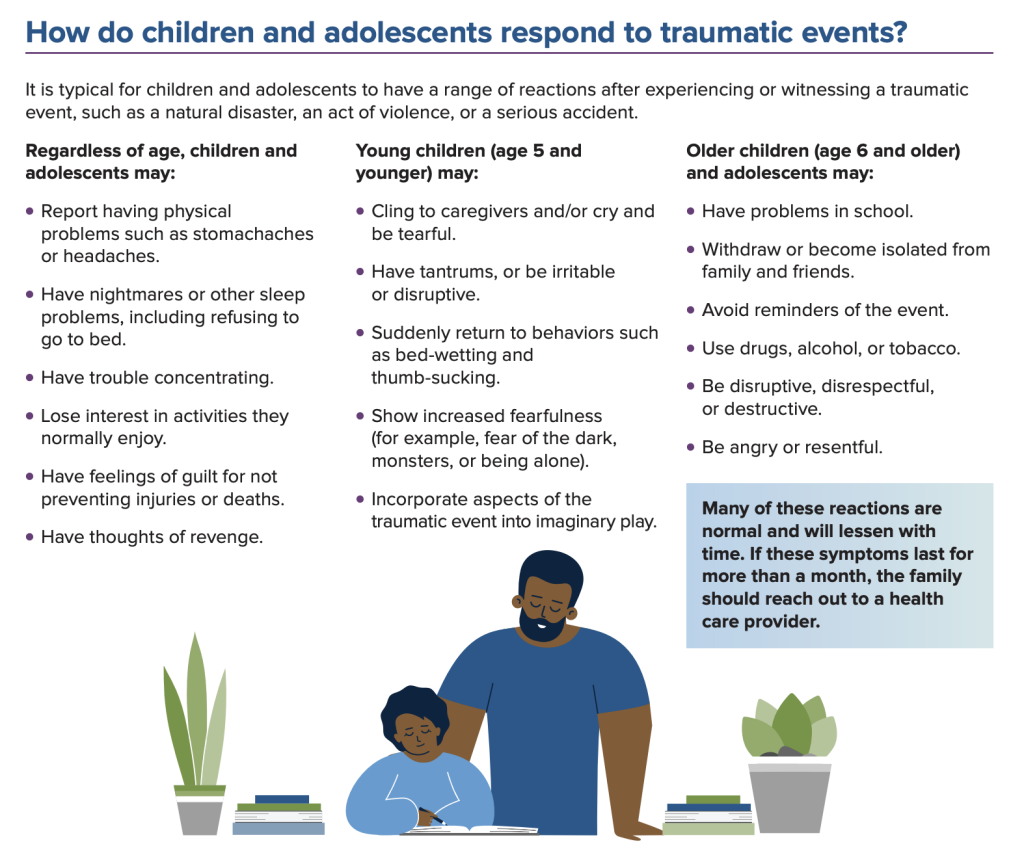When we hear news about mass violence or other traumatic events, we are all impacted on some level. Our guide to managing news-related stress has tips to help you maintain your mental health when news stories are frightening and/or heartbreaking. Below, information and resources to support those impacted by traumatic events.
Responses to Incidents of Mass Violence
Emotional distress is a normal response to a disaster/tragedy. Common feelings in response to incidents of mass violence include overwhelming anxiety, trouble sleeping, and other depression-like symptoms. Symptoms of distress may appear before, during, and after such an event and may manifest in the hours, days, weeks, months, or even years after they occur. Other signs of emotional distress related to incidents of mass violence may include:
- Feeling numb or like nothing matters
- Feeling helpless or hopeless
- Worrying a lot of the time; feeling guilty but not sure why
- Feeling like you have to keep busy
- Excessive smoking, drinking, or using drugs, including prescription medication
People at risk for emotional distress due to the effects of incidents of mass violence include:
Survivors. Injured victims as well as bystanders in close proximity to the event are especially at risk for emotional distress.
Friends and loved ones. It’s normal for friends and family members located outside the impacted area to feel anxious about people who are in direct proximity to an incident of mass violence.
First responders and recovery workers. These individuals may experience prolonged separation from loved ones during the incident and show signs of mental fatigue.
Community members. People who live the area surrounding the event may experience emotional distress.
(Source: SAMHSA)
Supporting Youth After Emergencies/Traumatic Events
Helping Children Cope with Emergencies (Centers for Disease Control); PDF flier
Tips for Talking With and Helping Children and Youth Cope After a Disaster or Traumatic Event: A Guide for Parents, Caregivers, and Teachers (Substance Abuse and Mental Health Services Administration)
Tips for Talking With and Helping Children and Youth Cope After a Disaster or Traumatic Event: A Guide for Parents, Caregivers, and Teachers (Substance Abuse and Mental Health Services Administration)
Helping Children and Adolescents Cope With Traumatic Events (National Institute of Mental Health); PFD flier
Talking with Children About Difficult Stories in the News (Fred Rogers Institute)
School Shooting Resources (The National Child Traumatic Stress Network)
Mass Violence Resources (The National Child Traumatic Stress Network)
California Surgeon General’s Stress Playbook and other resources

Children and adolescents may:
- Report having physical problems such as stomachaches or headaches.
- Have nightmares or other sleep problems, including refusing to go to bed.
- Have trouble concentrating.
- Lose interest in activities they normally enjoy.
- Have feelings of guilt for not preventing injuries or deaths.
- Have thoughts of revenge.
Young children (age 5 and younger) may:
- Cling to caregivers and/or cry and be tearful.
- Have tantrums, or be irritable or disruptive.
- Suddenly return to behaviors such as bed-wetting and thumb-sucking.
- Show increased fearfulness (for example, fear of the dark, monsters, or being alone).
- Incorporate aspects of the traumatic event into imaginary play.
Older children (age 6 and older) and adolescents may:
- Have problems in school.
- Withdraw or become isolated from family and friends.
- Avoid reminders of the event.
- Use drugs, alcohol, or tobacco.
- Be disruptive, disrespectful, or destructive.
- Be angry or resentful.
Many of these reactions are normal and will lessen with time. If these symptoms last for more than a month, the family should reach out to a health care provider.
